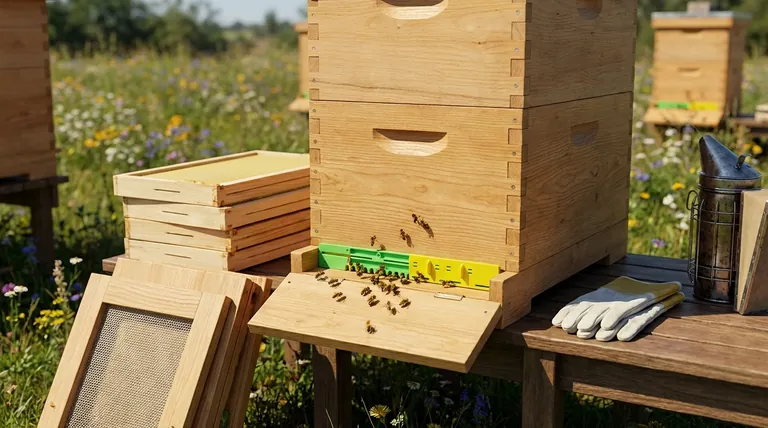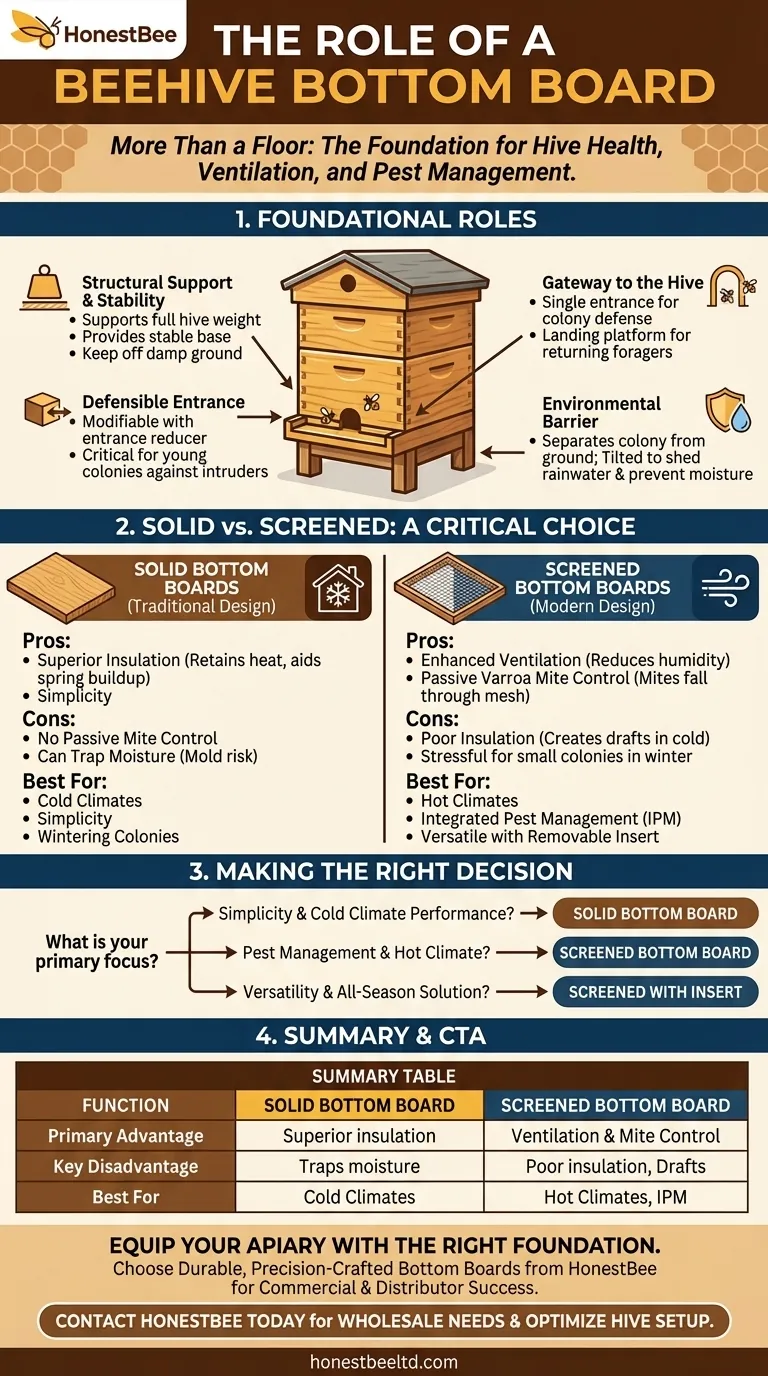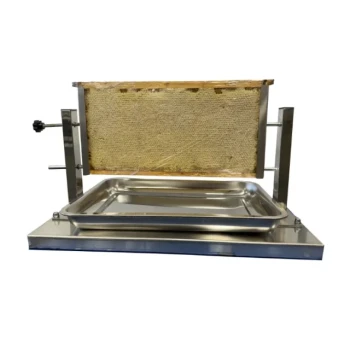At its core, a bottom board is the floor of a beehive, providing structural support for the entire colony and creating a single entrance for the bees. It serves as the foundation upon which the hive bodies are stacked and acts as the bees' takeoff and landing platform. While simple in concept, the type of bottom board you choose has significant implications for hive health.
A bottom board is far more than just the hive's floor. It is a critical tool for regulating the hive's internal environment—affecting ventilation, temperature, and pest management. The choice between a solid and a screened bottom board is one of the beekeeper's most fundamental management decisions.

The Foundational Roles of a Bottom Board
Before comparing types, it's essential to understand the universal functions that every bottom board serves, regardless of its design.
Structural Support and Stability
A bottom board supports the full weight of the hive, which can exceed hundreds of pounds when full of bees, brood, and honey. It provides a stable base that keeps the stacked boxes aligned. For longevity, it should be placed on a firm, raised surface to keep the wood off the damp ground.
The Gateway to the Hive
The bottom board creates the primary entrance and exit for the colony. This single point of entry is easier for guard bees to defend against intruders. The extended portion at the front also acts as a landing platform for returning foragers.
A Defensible Entrance
The entrance can be modified with an entrance reducer. This small block of wood restricts the opening's size, which is critical for young or small colonies that need help defending against threats like robbing bees, crickets, or mice.
Environmental Barrier
The bottom board separates the colony from the ground. Beekeepers often tilt the hive slightly forward, which allows the bottom board to shed any rainwater that might blow into the entrance, preventing moisture buildup inside the hive.
Solid vs. Screened: A Critical Management Choice
The most significant variation in bottom boards is the choice between a solid wood design and one that incorporates a wire mesh screen. This choice directly impacts how you manage your hive's health.
The Case for Solid Bottom Boards
The solid bottom board is the traditional design, made of solid wood. It creates a completely enclosed floor. This design provides better insulation, which can help the colony retain heat during colder months and may lead to a faster population buildup in the spring.
The Advantages of Screened Bottom Boards
A screened bottom board replaces most of the solid wood floor with a section of #8 hardware cloth (wire mesh). This modern design offers two primary benefits: superior ventilation and passive pest control. Increased airflow helps reduce humidity, especially in hot climates.
Most importantly, it is a key tool in managing Varroa mites. As these parasitic mites fall off bees during grooming, many will drop through the screen and out of the hive, unable to return. This also allows the beekeeper to place a "sticky board" underneath to monitor the mite population.
Understanding the Trade-offs
Neither design is perfect for every situation. Understanding their respective drawbacks is key to making an informed decision.
The Downside of Solid Boards
The primary weakness of a solid bottom board is its lack of ventilation. It can trap moisture, potentially leading to mold and mildew issues. It also offers no passive assistance in controlling Varroa mite populations, as fallen mites can easily climb back onto a host bee.
The Drawbacks of Screened Boards
While excellent for ventilation, a screened bottom board provides poor insulation. In cold climates, this can create a draft that makes it harder for the colony to maintain its cluster temperature. This can be particularly stressful for smaller colonies during winter.
Making the Right Choice for Your Apiary
Your choice should align with your climate, management style, and beekeeping goals.
- If your primary focus is simplicity and performance in a cold climate: A solid bottom board offers superior insulation, which is a significant advantage during long, cold winters.
- If your primary focus is pest management and hot-climate performance: A screened bottom board is the superior choice for its ventilation and built-in Varroa mite control.
- If you want a versatile, all-season solution: Choose a screened bottom board that includes a removable insert, which allows you to gain the benefits of a solid board during winter and a screened board in summer.
Understanding your bottom board transforms it from a simple floor into a powerful tool for ensuring a healthy, productive colony.
Summary Table:
| Function | Solid Bottom Board | Screened Bottom Board |
|---|---|---|
| Primary Advantage | Superior insulation for cold climates | Enhanced ventilation & passive Varroa mite control |
| Key Disadvantage | Can trap moisture; no passive mite control | Poor insulation; creates a draft in winter |
| Best For | Cold climates, simplicity, wintering colonies | Hot climates, integrated pest management (IPM) |
Equip Your Apiary with the Right Foundation
Choosing the correct bottom board is a fundamental decision for hive health and productivity. At HONESTBEE, we supply durable, precision-crafted bottom boards—both solid and screened—designed for the rigorous demands of commercial apiaries and beekeeping equipment distributors.
Our wholesale-focused operations ensure you get the reliable equipment you need to build strong, manageable colonies. Let us help you optimize your hive setup for superior results.
Contact HONESTBEE today to discuss your wholesale needs and discover how our beekeeping supplies can support your operation's success.
Visual Guide

Related Products
- Multi-Functional Sliding Hive Entrance for Beekeeping
- Professional Reversible Beehive Hive Entrance
- Metal Hive Feet Bee Hive Stand for Ant Protection
- Metal Bee Hive Stand Bee Box Stand for Beekeeping
- Beehive Entrance Discs Plastic Bee Entrance Disc for Bee Hives
People Also Ask
- What size is the entrance hole in a native bee hive? The 13mm Standard for a Thriving Colony
- What is the purpose of placing an object in front of the hive entrance after a move? A Guide to Forced Reorientation
- How does entrance configuration vary seasonally for beekeepers? A Guide to Year-Round Hive Health
- How do bees manage debris with a small hive entrance? A Guide to Strategic Hive Management
- Why is a smaller entrance size beneficial for a beehive? Boost Hive Defense & Productivity



















